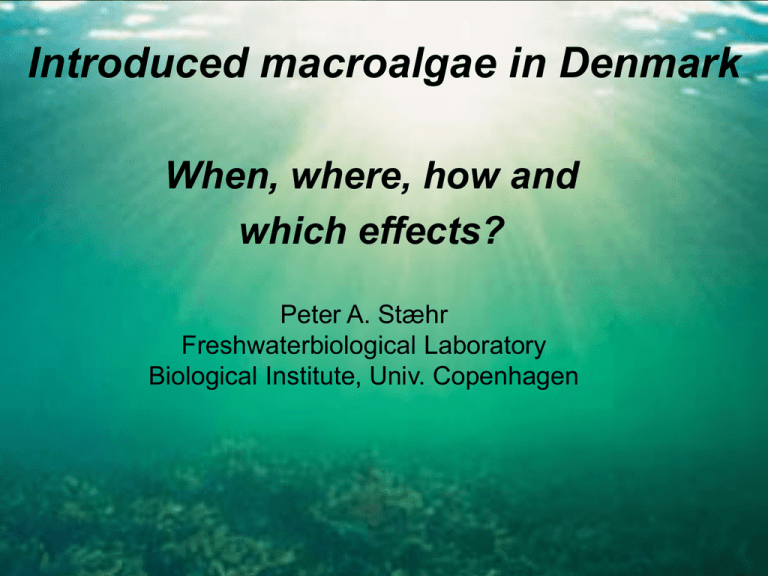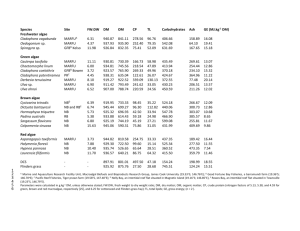Introduced macroalgae in Denmark When, where, how
advertisement

Introduced macroalgae in Denmark When, where, how and which effects? Peter A. Stæhr Freshwaterbiological Laboratory Biological Institute, Univ. Copenhagen Some ”basic” questions: What is a macroalgae? What characterizes an invasive macroalgae? Which steps are involved in macroalgal invasions? What are the likely impacts of an invasion? Macroalgae? Macroalgae? Steneck & Dethier 1994 Invasive macroalgae? Williams & Smith 2006 Number of introductions Invasive macroalgae? Williams & Smith 2006 Macroalgae in Danish waters Ns = North Sea Sk = Skagerrak K = Kattegat Lf = Limfjorden Sa = Northern beltsea Sb+Sm = Great belt Lb = Little belt Su = Oresound Bm+Bb = Baltic sea Map of diving locations in the Danish marine monitoring program. From 19892003: 9738 observations with 290 taxa, including 9 invasive Which macroalgal NIS? Red (159) Bonnemaisonia hamifera Dasya baillouviana Gracilaria vermiculophylla Polysiphonia elongella new! Heterosiphonia japonica = Dasysiphonia sp. Neosiphonia harveyi Which macroalgal NIS? Red (159) Bonnemaisonia hamifera Dasya baillouviana Gracilaria vermiculophylla Heterosiphonia japonica = Dasysiphonia sp. Neosiphonia harveyi Brown (126) Colpomenia peregrina Sargassum muticum Fucus evanescens Dictyota dichotoma Which macroalgal NIS? Red (159) Bonnemaisonia hamifera Dasya baillouviana Gracilaria vermiculophylla Heterosiphonia japonica = Dasysiphonia sp. Neosiphonia harveyi Brown (126) Colpomenia peregrina Sargassum muticum Green (91) Codium fragile ssp. tomentosiodes / scandiavicum Fucus evanescens Dictyota dichotoma Where from, how and when? Class Species Origin Transport Year Europe Year DK Red Bonnemaisonia hamifera Pacifics (Japan) Ship? 1890 (England) 1900 Red Dasya baillouviana Mediterranean Ship?/oysters? Natural 1961 Red Heterosiphonia japonica Pacifics Ship?/oysters? 1994 (Holland) 2005 Red Neosiphonia harveyi Epiphytes? 1908 (England?) 1986 Red Gracilaria vermiculophylla Ship?/oysters? 1935 (Norway?) 2003 Brown Colpomenia peregrina Pacifics Oysters? 1905 (France) 1939 Brown Fucus evanescens North Atlantics Ship / natural Natural 1948 Brown Sargassum muticum Pacifics (Japan) Oysters? 1960s (France?) 1984 Atlantic Brown Dictyota dichotoma Oysters / natural? Natural 1939 Green Codium fragile ssp. tomentosoides Atlantics (Japan) Ship/oysters? 1900 ca (Holland) Green Codium fragile ssp. scandinavicum Atlantics (Sibiria, Japan) Ship/oysters? 1919 (Denmark) Pacifics / NW Atlantics Pacifics 1919 Where and how much? Relativ dækning af samfund) of community) cover (% (% Relative Regional distribution 10 Bonnemaisonia hamifera Codium fragile Colpomenia peregrina Dasya baillouviana Dictyota dichotoma Fucus evanescens Gracilaria vermiculophylla Neosiphonia harveyi Sargassum muticum 1 0.1 0.01 0.001 Ns K+Lf Salty (34 ppm) Sa Lb Sb+Sm Regions Regioner Su Bw Bm+Bb Fresh (5-10ppm) Where and how much? 10 Bonnemaisonia hamifera Codium fragile Colpomenia peregrina Dasya baillouviana Dictyota dichotoma Fucus evanescens Gracilaria vermiculophylla Neosiphonia harveyi Sargassum muticum 1 0.1 0.01 Depth interval Dybdeinterval (m) (m) 26-28 24-26 22-24 20-22 18-20 16-18 14-16 12-14 10-12 8-10 6-8 4-6 2-4 0.001 0-2 cover (%(%ofafcommunity) Relativedækning Relativ samfund) Depth distribution Where and how much? Relativ cover dækning af samfund) of community) (% (% Relative Development in time 10 Bonnemaisonia hamifera Codium fragile Colpomenia peregrina Dasya baillouviana Dictyota dichotoma Fucus evanescens Gracilaria vermiculophylla Neosiphonia harveyi Sargassum muticum 1 0.1 0.01 Year Årstal 2003 2002 2001 2000 1999 1998 1997 1996 1995 1994 1993 1992 1991 1990 1989 0.001 Summary on Danish NIS • 10-12 ”new” species out of 376 total • NIS species amount to 3.75% of total cover • Most NIS in salty regions • Most at 2-4m (7%) and 20-22m (6%) • No obvious increase during recent years • Gracilaria is expected to spread fast • Lack of knowledge about NIS ecological impact in Dk more research Invasion phases: Donor population (1) Uptake, transport (2) Release and establisment (3) Spread (natural/associated) Effect (4) Impacts (large) 1 2 3 Time 4 Invasion of new populations Barriers of invasion: Donor region Geographical Physiological Life-history Biotic resistance Recipient region Sargassum muticum in Denmark – invasion and ecological effects Sargassum muticum - phenology • Large (>2m) brown macroalgae (order Fucales) • Related to Fucus vesiculosus and Halidrys siliquosa • Floating vesicles • Broad temperature (10-30 oC) and salinity (18-34 o/oo) tolerance • Monoecious ~self fertilizing • High regeneration ability • Pseudo-perenial life-cycle Invasion history • Origin – Asia (Japan) • 60’ies – North America -> Oysters • 70’ies – Europe (English Channel) -> oysters ?? • 1984 - Denmark -> oysters? -> sekundary spread (drifting)? 2000? Rang no. % of total macroalgal cover Temporal development in community structure Relative change 1990– 97 Sargassum muticum Halidrys siliquosa Epibionts on Sargassum (S) and Halidrys (H) No clustering Species richness Individual density Biomass ol lu sc a Cn i da ria ha et a Sargassum muticum Po lyc Po rif er a M Cr us ta ce a Ec hi no de rm at a Ur oc ho rd at a mgAFDW / 100g FW algae ± SE Same epifauna but more on Sargassum 2500 Halidrys siliquosa 2000 1500 1000 500 0 Seasonal variation in standing biomass Sargassum Large fluctuation in growth, production and loss Loss to grazers = 1-2% 99% of production is accumulates as detritus Halidrys Even growht, production and loss Fast decomposition fast release Impacts of S. muticum in Denmark • Since the introduction in 1984, Sargassum muticum has become the most common macroalgae in Limfjorden • The invasion has changed the macroalgal community structure with significant reductions in the cover of other large perennial browalgae • The invasionen has not changed the epifaunal species composition, but has increased epifaunal abundance and seasonal variation • The invasionen has resulted in a more unstabil and fluctuating biomass, with faster growth, turnover and nutrient release, similar to systems experiencing eutrophication Litterature: • Wernberg-Møller, Thomsen & Stæhr (1998). Master thesis, RUC. • Wernberg-Møller, Thomsen & Stæhr (1998). Urt 22:128-132. • Stæhr, Pedersen, Thomsen, Wernberg & Krause-Jensen (2000). Mar Ecol-Prog Ser 207:79-88. • Wernberg, Thomsen, Stæhr & Pedersen (2001). Botanica Marina 44:31-39. • Wernberg, Thomsen, Stæhr & Pedersen (2004). Helgoland Marine Research 58:154-161. • Pedersen, Stæhr, Wernberg & Thomsen (2005). Aquatic Botany 83:31-47. •Thomsen M., Krause-Jensen D., Wernberg T., Stæhr P.A. og Nils Risgaard-Petersen. (2005) Fremmede tangarter i Danmark: Hvilke? Hvor udbredte? Hvornår? Urt 29: 110-115 • Thomsen, Wernberg, Stæhr & Pedersen (2006). Helgoland Marine Research 60:50-58. •Thomsen MS, Wernberg T, Stæhr PA, Krause-Jensen D, Risgaard-Petersen N, Silliman BR. 2007. Alien macroalgae in Denmark - a national perspective. Marine Biology Research 3: 61-72 Further information (Mads Thomsen website on NIS): http://cem.ecu.edu.au/coastal-marine/themes/reefecology/marine_invaders_bibliography.php
